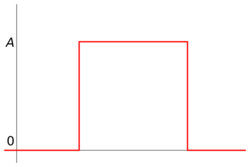Boxcar function

In mathematics, a boxcar function is any function which is zero over the entire real line except for a single interval where it is equal to a constant, A.[1] The function is named after its graph's resemblance to a boxcar, a type of railroad car. The boxcar function can be expressed in terms of the uniform distribution as where f(a,b;x) is the uniform distribution of x for the interval [a, b] and is the Heaviside step function. As with most such discontinuous functions, there is a question of the value at the transition points. These values are probably best chosen for each individual application.
When a boxcar function is selected as the impulse response of a filter, the result is a simple moving average filter, whose frequency response is a sinc-in-frequency, a type of low-pass filter.
See also
References
- ↑ Weisstein, Eric W.. "Boxcar Function". MathWorld. http://mathworld.wolfram.com/BoxcarFunction.html. Retrieved 13 September 2013.
 |
